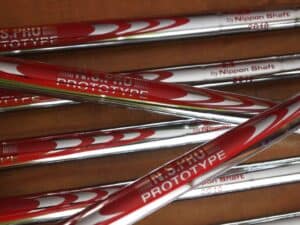- Updated: January 11, 2024
Stiff Shaft vs. Regular Shaft for Golf Irons
Most simply put, a regular flex shaft requires less force and swing speed generated during the golf swing to be used efficiently compared to a stiff shaft.
In general, if you have a faster swing speed you should use stiff shafts and if you have a slower swing speed you should use flex shafts on your irons.
Nick Sherburne, the founder of one of the world’s largest club fitting franchises Club Champion, believes 90 percent of average and recreational players use a shaft flex that isn’t optimal for their swing potential.

In our discussion below, we’ve taken the question of “Which type of golfer will benefit from a regular or stiff shaft?” and broken it down into easy to understand sections. After our shaft flex guide, readers will know how to determine which flex shafts they might need and how to tell if their current shaft flex isn’t producing as good of results as possible.
Golf Club Shaft Flexes 101:
There are a few key distinctions that need to be made about stiff vs. regular flex iron shafts.
Obviously, stiff flex shafts will be less flexible than regular flex shafts, but a few other differences are crucial to understand.
Stiff Flex Shafts
Harder to bend.
Often heavier than regular flex shafts.
It can support fast swing speed players’ force generated during a golf swing.
Almost always a lower ball flight with less spin.
Regular Flex Shafts
Easier to bend.
Often lighter than stiff flex shafts.
Slower swing speeds often see benefits in height, trajectory, and distance.
Almost always a higher ball flight with more spin.
As we already discussed, regular flex iron shafts require less force and swing speed to be used efficiently compared to stiff shafts, but what does that actually mean?
Essentially, slower swing speed players, whether they be seniors, beginners, or the majority of amateurs, often don’t generate the necessary force during their golf swing to require a stiff flex iron shaft, but this isn’t always the case.
Shaft Stiffness/Flex Shocking Fact:
UST Mamiya, one of the industry leaders in manufacturing some of the most innovative shafts for woods, hybrids, and irons since 1991, has previously said that through their independent testing, they found very inconsistent measurement data to determine which type of shaft flex will benefit which type of golfer.
In their words, “Sometimes a slower swinger needs an X-flex. Sometimes a big hitter needs a mere stiff. It’s all about fitting the individual, and there are no hard and fast rules.”

“If one of the world’s largest shaft manufacturers says there aren’t any definite rules to determining what type of shaft flex a person needs, what are my options for finding the best shaft as an amateur?”
While there aren’t any specific rules that will 100% guarantee the proper shaft fitting, leading shaft and golf equipment manufacturers use three significant factors to help determine their start point.
Once you know the answers to these variables that will be unique to every golfer’s swing, you’ll know where to begin looking online if you’re unable to be professionally fit, or you’ll know what information to give to your professional fitter.
Determine Your Swing Speed (Clubhead Speed)
Having a firm idea of your swing speed, also known as your clubhead speed, will help any player that’s unable to seek out a professional club shaft fitting.
Even though swing speed shouldn’t be the determining factor in deciding between a stiff or regular flex iron shaft, it is the first factor nearly every major shaft creator looks at when determining what shaft flex you may need.
The most proper way to determine your swing speed would be to seek out the help of your local professional club fitter. Since that isn’t an option for many amateurs, resources such as Top Golf or many “Big Box Golf Stores” often have monitors that will tell you this data.
How Clubhead Speed Affects Carry Distance
| Clubhead Speed (mph) | 60 | 70 | 80 | 90 | 100 | 110 | 120 | 130 | 140 |
|---|---|---|---|---|---|---|---|---|---|
| Club 🡇 | Carry Distance (yds) 🡇 | ||||||||
| Driver | 144 | 168 | 192 | 216 | 240 | 264 | 288 | 312 | 336 |
| 3-Wood | 130 | 152 | 174 | 195 | 217 | 239 | 260 | 282 | 304 |
| 5-Wood | 123 | 144 | 164 | 185 | 205 | 226 | 246 | 267 | 288 |
| 3-Hybrid | 121 | 141 | 161 | 181 | 201 | 221 | 241 | 261 | 281 |
| 3-Iron | 114 | 133 | 151 | 170 | 189 | 208 | 227 | 246 | 265 |
| 4-Iron | 109 | 127 | 145 | 163 | 181 | 199 | 218 | 236 | 254 |
| 5-Iron | 104 | 121 | 139 | 156 | 173 | 191 | 208 | 225 | 243 |
| 6-Iron | 98 | 114 | 131 | 147 | 163 | 180 | 196 | 212 | 229 |
| 7-Iron | 92 | 108 | 123 | 138 | 154 | 169 | 184 | 200 | 215 |
| 8-Iron | 86 | 100 | 114 | 129 | 143 | 157 | 171 | 186 | 200 |
| 9-Iron | 79 | 93 | 106 | 119 | 132 | 145 | 159 | 172 | 185 |
| P-Wedge | 73 | 85 | 97 | 109 | 121 | 134 | 146 | 158 | 170 |
If neither of the two above options are available to you, the attached chart will give players a general idea of their swing speed related to their carry distances. For example, say your average carry distance with your 7 iron is 169 yards. Following the graph we included, that would make your relative clubhead speed 110 miles per hour.
As a general rule, slower swing speed golfers have better distance and ball flight control with weaker iron shafts than stiffer ones. Still, as we’ve determined with the help of major shaft makers, there should be other factors looked at when deciding between regular vs. stiff.
Determine Your Current Ball Flight vs. Your Ideal Ball Flight
Most golfers have heard great iron players describe seeing the ball come off the clubface “in the right window,” but what does that actually mean? This is a golfer’s way of describing the ball launches at an angle off the club face that inspires confidence in the player that their golf ball is going to end up at their intended target.
Your ball’s trajectory during its flight will lend a hand in determining whether a regular flex or stiff flex iron shaft will work better for your swing.
For example, if you’re a right handed player who tends to have mis-hit shots end up higher in the air and be drastically affected by wind, you may be playing too light or weak of a shaft for the force generated during your swing.
Alternatively, if you’re a right handed golfer who tends to have errant shots be low in ball flight and feel “uncontrollable,” your stiffer shafts might not allow enough energy to be transferred to the ball during contact.
Many golfers only realize they have the wrong flex or are playing the wrong shafts by noticing the ball consistently misses in one of these areas. If you’re left handed, just reverse the directions listed above.
Take the information of your most common ball flight, your mis-hit shot ball flight, and your dream ball flight to your golf gear expert, and they will have a great starting point to begin finding you the right flex for your irons.
Tempo
Tempo is one of the more overlooked aspects of proper iron shaft fitting, and the attached video explains the different needs of a fast versus an “easy” relaxed tempo. Your “tempo” is another way of saying how you transition from the top of your backswing to making contact.
To explain the example used in True Tempers video, faster tempo swings will require stiffer flex shafts than easier tempo swings due to greater force being created from the quicker tempo.
How to Self-Diagnose Between Regular and Stiff Shafts
Now that you have a clear idea of your swing speed (clubhead speed) and ball flight characteristics of misses and well-struck shots, you do have near endless online resources to give suggestions for the right shaft flex for your swing, but we would never recommend using these tools over a professional club fitter.
That being said, we understand that professional fittings are a luxury that only a small percentage of the golfing population gets to experience, and have listed some of the greatest online shaft fitting resources for your convenience below.
Take the information gathered from the questions we discussed above and input the data into any of these sites:
https://www.titleist.com/fitting/golf-club-fitting/golf-shafts
What Makes a Professional Iron Shaft Fitting Worth The Money?
Besides having the tools and resources to allow golfers to test many different shaft flexibilities with accurate and confirmable data tracking, pro club fitters test and look for additional factors that even professional golfers have no idea of knowing.
These factors include testing shafts with varying “kick points” and whether or not “tipping a shaft” would be beneficial to your golf game.
Kick Point
A shaft’s “kick point” (also referred to as a “bend point” or “flex point”) is the area of the shaft that bends the most during the golf swing. Shaft creators label their shafts varying kick points as “Low Kick Point,” “Mid Kick Point,” or “High Kick Point,” depending on where the area of flex occurs, and each style of kick point directly relates to the ball flight achieved.
Low Kick Point = Higher Trajectory
Mid Kick Point = Mid Trajectory
High Kick Point = Lower Trajectory
Fitting professionals will have the knowledge from previous experiences and years of seeing other swing tempos to know after a few swings if a lower or higher kick point shaft will be needed to achieve better results with your swing.
Shaft Tipping
In the simplest terms, “shaft tipping” is when a club builder removes length from the “tip” of a golf club’s shaft (where the head connects to the shaft) to increase stiffness as well as torque (resistance to twisting through impact).
Only a professional master fitter with considerable experience in the field will know if an iron shaft being “tipped” will directly benefit the way the ball behaves off your club face.
This insider “club fitter knowledge” leads to tighter shot dispersions, more reliable and consistent carry yardages, and more ball flight and trajectory control for players.
Final Thoughts on Stiff vs. Regular Flex Irons
When deciding between stiff and regular flex iron shafts, there are several factors that should go into your decision, including some that aren’t detectable to the untrained eye.
First, golfers should evaluate their swing speed using our chart above or a speed testing tool of some kind. As we discussed, usually, slower swing speeds have greater results with weaker iron shafts, but that isn’t always the case.
Next, players should think about the ball flight you most commonly see during well struck shots and poorly struck shots. If you’re repeatedly missing in a similar pattern, you might be playing the wrong shaft for your swing.
Lastly, evaluate your swing on film and recognize if your tempo is fast or relaxed.
You now have a lot of the necessary information to make a more wise decision between regular flex or stiff flex irons and how to determine the irons you’re currently playing with are the proper fit.
If you have the time, and resources, and live in a location close to a professional fitting expert, take the above information to them. They will be the best to determine whether a stiff or regular flex shaft will best benefit your game.
How a Shaft Flex Fitting Saved the Author 6 Strokes
I played competitively in high school but didn’t play more than a few times a year in college. After completing my studies, I decided to dedicate myself to the game once again. During my time spent passively playing the game in college, I grew a few inches and added over 30 pounds to my frame, gaining a lot of strength and speed at the same time.
I realized that I no longer had the issue of a lower ball flight with my irons, and if anything, now had a problem of having too much height with my long irons resulting in a loss of reliable carry distances.
I paid for a professional club fitting and was shocked to find my swing speed and unique swing characteristics led me to find shafts that were 40 grams heavier and “Tour Stiff” compared to my previous 90 gram stiff flex iron shafts.
The difference in dispersion between my older iron shafts and newer iron shafts was daylight and dark.
The substantially heavier and stiffer shafts resulted in me gaining control of my ball flight, exponentially more distance, and the ability to repeat results for accurate carry yardages to take to the golf course.
My handicap instantaneously dropped from an 8 to a 2, and I’ve been singing the praises of professional shaft fittings ever since.
About The Author
Writers of Independent Golf Reviews
Independent Golf Reviews has tested and reviewed 1000+ golf products over the past 10 years. We use our experience and expertise to give golfers an unbiased insight on the market.
Read more…
Share
Receive the best golf discounts available exclusively for our subscribers and be auto entered into our monthly golf giveaways!
Success!⛳️
You are now an official member of IGR. Keep an eye out for the perks.
No spam, ever. 🔒

